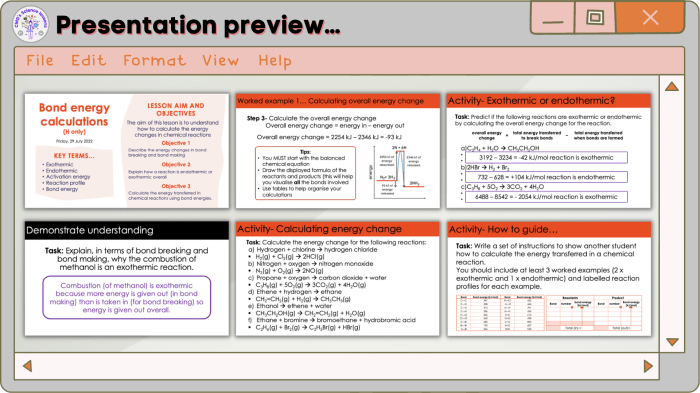Changes in bond energy quick check delves into the captivating world of chemical reactions, providing a comprehensive overview of the fundamental principles that govern the formation and breaking of chemical bonds. This guide offers a concise and accessible exploration of the factors influencing bond energy, the methods employed to measure these changes, and their far-reaching applications in predicting and optimizing chemical processes.
As we delve into the intricacies of bond energy changes, we will uncover the significance of bond length, bond order, and electronegativity in shaping the energy landscape of molecules. We will examine the experimental techniques used to quantify these changes, such as calorimetry and spectroscopy, and critically evaluate their advantages and limitations.
Overview of Bond Energy Changes: Changes In Bond Energy Quick Check

Bond energy is the amount of energy required to break a bond between two atoms. It is a measure of the strength of the bond and is an important factor in determining the stability of molecules and the reactivity of chemical compounds.
The bond energy of a bond is affected by several factors, including the bond length, bond order, and electronegativity of the atoms involved.
Methods for Determining Bond Energy Changes
There are several experimental techniques that can be used to measure bond energy changes. Calorimetry measures the heat released or absorbed when a bond is broken or formed. Spectroscopy measures the energy of the light absorbed or emitted when a bond is broken or formed.
- Calorimetry: This technique involves measuring the heat released or absorbed during a chemical reaction. The heat released is equal to the difference in bond energies between the reactants and products.
- Spectroscopy: This technique involves measuring the energy of light absorbed or emitted during a chemical reaction. The energy of the light is equal to the difference in bond energies between the reactants and products.
Applications of Bond Energy Changes, Changes in bond energy quick check
Bond energy changes are used to predict the spontaneity of chemical reactions. A reaction is spontaneous if the total bond energy of the products is less than the total bond energy of the reactants. Bond energy changes are also used to design and optimize chemical processes.
By understanding the bond energies of the reactants and products, chemists can design reactions that are more efficient and produce the desired products in higher yields.
Advanced Concepts in Bond Energy Changes
The concept of resonance is important in understanding bond energy changes. Resonance occurs when there are multiple possible Lewis structures for a molecule. The resonance structures have the same number of electrons and atoms, but the electrons are arranged differently.
The actual structure of the molecule is a hybrid of the resonance structures. Resonance can affect the bond energy of a molecule. For example, the benzene molecule has a resonance structure that results in the carbon-carbon bonds being shorter and stronger than would be expected for a single bond.
Q&A
What is bond energy?
Bond energy is the amount of energy required to break a chemical bond, typically expressed in kilojoules per mole (kJ/mol).
How is bond energy measured?
Bond energy can be measured using experimental techniques such as calorimetry and spectroscopy.
What factors affect bond energy?
Bond energy is influenced by factors such as bond length, bond order, and electronegativity.
How is bond energy used in chemistry?
Bond energy is used to predict the spontaneity of chemical reactions and design and optimize chemical processes.


